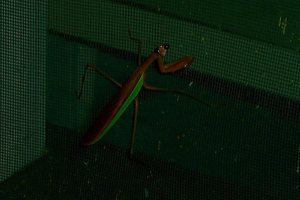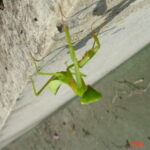Sure, we all know that bugs are just bugs. But what happens when you find a bug that makes a really good pet? Well here’s what happens. You learn things that you never knew about that bug before. In this case, I’m talking about praying mantises aka mantids. Praying mantises are cousins of roaches. They are best known for their stance that makes them look as if they’re praying while they wait for their food to come by. Most people are scared of bugs or they just don’t like bugs and so they will sooner kill one than learn more about it and get to know it. In terms of having a bug for a pet, praying mantises are best because they are active, easiest to take care of, and have a personality. For anybody who’s considered, or wanted to try, having a bug for a pet, I suggest a praying mantis. Below are the little tidbits on how to take care of them and things that I myself have learned from them by having them as pets.
1. Handling – These bugs are pretty sturdy but remember that in the hands of a human they are fragile little bugs. It doesn’t take much to accidentally rip off a leg, wing, or antenna. If you want to pick it up, let it crawl onto your hand. You may have to give it a small nudge forward to convince it to move but allowing it to move freely and crawl onto your hand is less harmful than picking it up like a Lego block. Remember that these are living creatures and so if they continuously refuse then just don’t force them. Normally if you force it, a praying mantis will eventually get tired of being “Mr./Ms. Nice Guy/Girl” and will draw back in a striking position. If it continues to be harassed, it may strike and bite to get the message across. And I can assure you, these creatures have a bite that’s strong enough to rip open a lizard’s skin, so it will definitely hurt.
2. Feeding – Now speaking of striking, biting, and tearing up lizards, it is time to talk about feeding. A praying mantis is a hunter. It uses ambushing and stalking to catch it’s food which will range from tiny bugs like aphids to small lizards like anoles and geckos. The one that my former roommate and I had wasn’t too picky about what she ate as long as she could eat. We also found out shortly after getting her that she was eating for over 500. At first we had a hard time getting live bugs for her so i decided to tie a 2″ piece of clear sewing thread to the foot of a dead katydid and plop it in the mantis’ box and move the dead bug around with the string – while keeping my hand hidden – so that it would appear alive and she would stalk and catch it. My plan worked and we had to regularly rely on it because of the difficulty we had finding live food. Live food is better because it allows the insect to hunt more naturally when it comes to elusive prey and fluids but dead bugs work just as well. Something we did notice about our mantis was that she would start at the neck/head of the bug when she would start eating and then she would use her front legs to rip the limbs of the bug off, all while it was still alive.
3. Watering – Moving onto drinks. A bug is like any other living thing in terms of needing fluids to survive. With our mantis, what we would do is take a plastic bottle cap and fill it with water and put it at the bottom of the box that we kept the mantis in. Normally we would have to put her over by it so she would know that she had water and sometimes she would start drinking it as soon as she realized that it was there for her. Something else that might also work is piece of a sponge that has been soaked in water. This method is used for watering crickets and it does help to keep them hydrated.
4. Light – We learned that a praying mantis has night vision as well as it’s day vision. Unlike humans, you can tell which one its using. We learned this after realizing that our mantis’ eyes were black every time we took her out of her windowed shoe box for a half hour or so and then when we would put her back in, her eyes would be as green as they were the day we got her. So light really doesn’t seem to be a very big deal but I’m sure that it would still be enjoyed though. What we did was cut a rectangular hole in the top of the shoe box and then we taped one of our used clear welding lenses under the lid and that did the trick. Gave her a window to look out of, light so she wouldn’t be stuck in the dark the whole time if she didn’t want to be, and it gave us the ability to look in on her from time to time when we didn’t have time to open her box to check up on her.
5. Things to do – These bugs are pretty active and they love to climb on stuff. Adding things like small branches would be good for them to do something they enjoy.
6. Cleaning – OK, these critters are some of the cleanest bugs I have ever seen. Almost every time I have turned around, they are holding a leg or an antenna up to their mouth to clean themselves. Almost makes you feel like their private bathtub when they do this on you. Unfortunately though, they can’t clean out their living space. And as clean as the bugs themselves are, their living space can get pretty nasty looking real quick. We found ourselves letting our mantis run loose in the room while we would clean out her box at least three times a week. And sometimes we couldn’t tell the difference between mantis wast, tree bark, and bug parts. But thankfully it doesn’t take all that long to take care of the cleaning.
Hopefully this guide is helpful to you. Especially if you plan on keeping one of these for a pet. Once you take the time to watch and handle them and care for them, you’ll be able to realize that they are much cooler than what any nature show can tell you. So for those of you that are considering new pet ideas or just raising a praying mantis for a science project, This guide should make things much easier for you. Enjoy.






